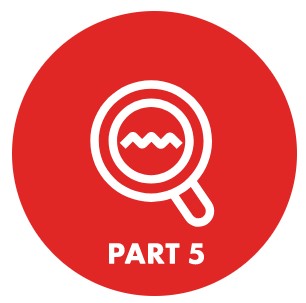The Basics of Modal Analysis for Electric Motors and Powertrains (Series)
August 17, 2021
This blog post continues an 8-part series on vibration analysis written by Dr. Sara McCaslin & Nolan Crowley, Business Development Manager at HECO.
Dr. Sara McCaslin: Sara has a Ph.D. in mechanical engineering from the University of Texas at Arlington. Sara has also taught materials science, manufacturing, and mechanical system design at the University of Texas at Tyler.
Nolan Crowley: Nolan is a Business Development Specialist for HECO. Nolan has BS from Miami University along with extensive field experience with powertrains, electric motors, & vibration issues since 2007.
- Week 1: Vibration Analysis Training: Who’s Doing Your Analysis?
- Week 2: Vibration Analysis Equipment: Sensors and Hardware
- Week 3: Balancing Rotating Equipment: Static vs Dynamic
- Week 4: The Importance of Route-Based Data Acquisition
- Week 5: The Basics of Modal Analysis for Electric Motors and Powertrains
- Week 6: How to Setup Remote Monitoring Vibration Monitoring
- Week 7: The Place of Motion Amplification in Modern Vibration Analysis
- Week 8: Bidding/Specifying Your Vibration Analysis Program
Have you ever heard of the Tacoma Narrows bridge collapse? Many vibration experts agree that the twisting and ultimate failure was caused by resonant conditions. When the wind eddies matched the natural frequency (or frequencies) of the bridge, the swaying and “galloping” motion of the bridge increased dramatically.
https://www.youtube.com/watch?v=j-zczJXSxnw&t=1s
Video of the Tacoma Narrows bridge twisting apart
If resonant conditions can bring down a steel and concrete bridge, what can it do to your electric motor and power train? The good news is that there is a way to detect and correct resonant conditions: modal analysis.
Natural Frequencies and Modes
Every structure has a natural vibration frequency that will cause it to deform, as we saw with the Tacoma Narrows bridge. According to vibration analysis theory, a complex structure will have multiple natural frequencies, where each one is an integer multiple of the lowest one. Vibration at a frequency that matches that natural frequency (or is very close to it) results in resonance conditions and extremely large amplitude vibration and displacement of the system.
When a structure is excited at one of these frequencies, it will have a certain shape that it takes on. The shapes are referred to as modes, and there is a mode of vibration for every natural frequency. The mode associated with the lowest natural frequency is called the first mode. The video below shows examples of how these modes look for an extremely simple system.
Demonstrating various modes using a string
Formulas can be developed to determine the natural frequencies and modes for very simple systems, such as a cantilever beam (i.e., a beam attached to a wall at one end and free at the other) or simple beams (i.e., supported at both ends). However, as systems become more complex so does the process of determining the resonant frequencies and modes of vibration.
Practical Modal Analysis
Modal analysis refers to a group of vibration analysis methods used to determine the natural frequencies of mechanical structures. It requires a different approach for gathering, processing, and analyzing the data. There are other methods for detecting the resonant conditions, including FEA (Finite Element Analysis) and ODS (Operating Deflection Shape), but we are going to talk about the “bump test”.
The bump test (sometimes referred to as an impact test) exclusively uses vibration analysis data and techniques, unlike FEA and ODS. Basically, it applies an external force to the structure and then collects and measures data about its dynamic response.
In this method, the electric motor or powertrain is shut down. Next, an external force is applied with an instrumented hammer, shaker, or some other type of vibration exciter that provides you with data about the force applied and accelerometers measure the dynamic response of the system.
The impact data and the dynamic behavior are received by a dual-channel FFT analyzer. One channel receives the impact force data and the other channel receives the dynamic response of the structure. Note that the data provided to these two channels are all in the time domain–the FFT analyzer converts the data to the frequency domain using a mathematical process known as FFT (Fast Fourier Transform).
Once the data is all in the frequency domain, some additional mathematical operations are performed on it to obtain a vibration spectrum plot (displacement versus frequency). Spikes with wide bases appearing in the plot point to the natural frequencies of the structure.
Using the Results of Modal Analysis
So now the vibration analysis has a good idea of what the natural frequencies of the system are–what next? Once the natural frequencies are known, the vibration analyst will recommend steps to be taken to avoid exciting the structure of the motor or powertrain within a certain tolerance of those frequencies. An old rule of thumb is that forcing frequencies should never fall within 10% of the natural frequencies. However, if the cause of resonant forcing frequencies just cannot be adjusted, there are other options such as damping.
So what can be the source of forcing frequencies?
Forcing frequencies can include the output torque of an electric motor, the speed at which the system is running, compressor thread rates, an unbalance in the system, or gear mesh rate. And resonance conditions aren’t necessarily present all the time. For example, issues may only occur at startup or shutdown of the system where speeds are changing.
Conclusion
Modal analysis can be used to detect and address problems with resonant conditions, whether it’s just a motor being affected or an entire powertrain. And left unaddressed, it will lead to serious damage and catastrophic failure of your equipment.
If you’ve got something in your facility that is shaking way more than it should be, let the certified vibration analysts at HECO help. Our Predictive Service Group performs advanced vibration testing and modal analysis to help you resolve resonant conditions and prevent further damage to your system.
Posted in Predictive
